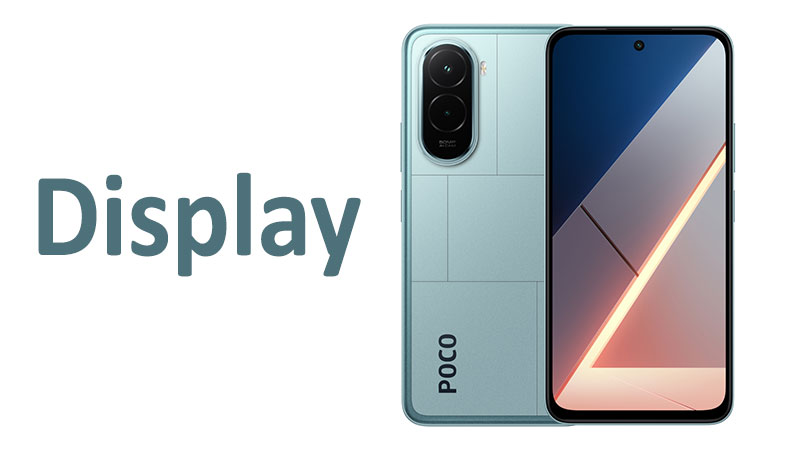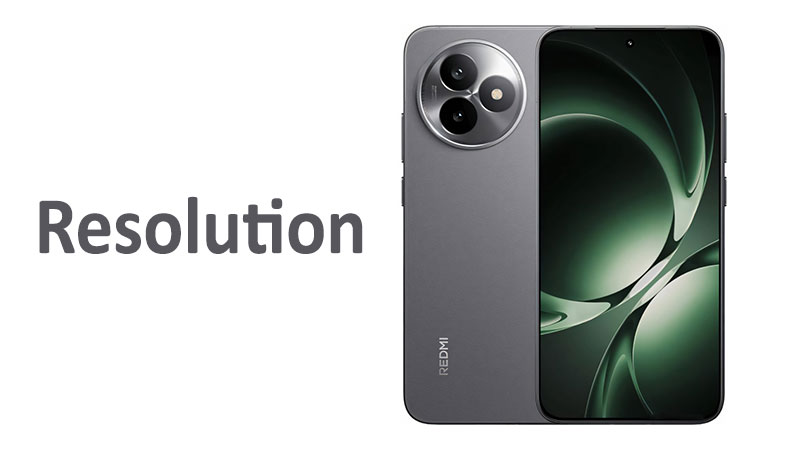The display is the window to your digital world. It’s the primary way you interact with your smartphone. For many users, a great display is a non-negotiable feature. It determines how enjoyable your gaming, streaming, and everyday scrolling experiences are. This is why the Xiaomi Poco M7 Plus display is a critical point of interest. It promises a combination of high-end features at a very competitive price point. This article provides a comprehensive look at the display’s resolution, quality, and features, helping you understand what makes it stand out.
Display Specifications
The Xiaomi Poco M7 Plus comes equipped with a display that boasts some impressive numbers, especially for its price segment. Let’s break down the core technical specifications that define its performance.
- Type: IPS LCD, 144Hz, 700 nits (typ), 850 nits (HBM)
- Resolution: 1080 x 2340 pixels, 19.5:9 ratio (~374 ppi density)
- Protection: Corning Gorilla Glass 3
These specs lay the foundation for a display that is both vibrant and smooth. They also highlight a strategic choice by Xiaomi. While some competitors opt for AMOLED, the Poco M7 Plus utilizes an advanced IPS LCD panel. This decision has a direct impact on the user experience.
Resolution and Clarity: Sharpness Meets Affordability
The Poco M7 Plus features a Full HD+ resolution of 1080 x 2340 pixels. This resolution, combined with its 6.9-inch size, results in a pixel density of approximately 374 ppi (pixels per inch). A higher ppi means that individual pixels are less visible. This contributes to sharper images and crisper text.
For most daily tasks, this resolution is more than adequate. It ensures that videos and photos are detailed and clear. Reading articles and browsing the web is a pleasant experience. The images are not pixelated, and the text is easy on the eyes. This is a solid choice for a budget-friendly phone. It strikes a great balance between visual quality and power efficiency.
Resolution Comparison
Compared to a standard HD+ display, the Poco M7 Plus’s Full HD+ panel is a significant upgrade. The difference in sharpness is immediately noticeable. However, it doesn’t quite reach the ultra-crispness of a flagship phone’s QHD+ display. For its segment, though, the resolution is a strong selling point. It outperforms many rivals that still use lower-resolution panels.
The Refresh Rate Revolution: 144Hz of Smoothness
One of the most impressive features of the Xiaomi Poco M7 Plus display is its 144Hz refresh rate. This is a major highlight that sets it apart from the competition. A higher refresh rate means the screen updates more frequently. The result is a much smoother visual experience.
Scrolling through social media feels fluid and responsive. Gaming becomes more immersive. Animations and transitions are buttery smooth. The 144Hz refresh rate is a feature typically found on more expensive gaming phones. Its inclusion here provides a significant performance advantage for users.
Refresh Rate in Action
The refresh rate is most evident during fast-paced actions. When you’re playing a game, the on-screen movement is more responsive. It can give you a competitive edge. Even simple tasks like opening and closing apps feel faster and more polished. It’s an adaptive refresh rate, which means it can adjust automatically. This helps to save battery life when a high refresh rate isn’t needed.
Brightness and Viewing Angles: Conquering the Outdoors
The Poco M7 Plus display offers a typical brightness of 700 nits. It can reach a peak brightness of 850 nits in High Brightness Mode (HBM). This is a crucial detail for outdoor visibility. A brighter screen is easier to read under direct sunlight.
The 700-nit typical brightness is perfectly fine for indoor use. It provides a vibrant and clear picture. The 850-nit HBM, however, is what makes it a practical choice for outdoor use. Many budget phones struggle in bright conditions. The Poco M7 Plus display overcomes this limitation effectively. Its IPS LCD technology also provides excellent viewing angles. Colors and brightness remain consistent even when viewed from the side.
Pros and Cons of the IPS LCD Panel
The choice of an IPS LCD panel is a key factor in the Poco M7 Plus’s overall performance. Let’s look at the advantages and disadvantages of this technology.
Pros of IPS LCD
- Cost-Effective: IPS LCD panels are generally more affordable to produce than AMOLED screens. This allows Xiaomi to offer a high refresh rate and a large display at a lower price point.
- Good Color Accuracy: IPS panels are known for their accurate and natural color reproduction. They don’t oversaturate colors. This makes them great for photo editing and general content consumption.
- No Burn-In Risk: Unlike AMOLED displays, IPS panels are not susceptible to screen burn-in. This gives them a longer lifespan and makes them more durable over time.
Cons of IPS LCD
- Less Deep Blacks: IPS LCDs use a backlight. This means that true blacks are not possible. They appear as dark gray. AMOLED displays, in contrast, can turn off individual pixels for perfect blacks.
- Higher Power Consumption: IPS panels tend to consume more power than AMOLED displays. This is especially true when showing a lot of white content. The backlight is always on, which can drain the battery faster.
- Lower Contrast Ratio: The contrast ratio on an IPS panel is lower than on an AMOLED panel. This can make the image look less “punchy” compared to its OLED counterparts.
Despite these drawbacks, the IPS LCD on the Poco M7 Plus is a high-quality panel. It provides a fantastic user experience. The trade-offs are well-justified for the price.
Durability and Protection: Built to Last
The Poco M7 Plus display is protected by Corning Gorilla Glass 3. This is an important detail for long-term ownership. Gorilla Glass is a brand of chemically strengthened glass. It is designed to be scratch and drop-resistant.
Gorilla Glass 3 provides a decent level of protection against daily wear and tear. It helps prevent minor scratches from keys or coins. While it’s not the latest generation of Gorilla Glass, its inclusion is a welcome addition. It adds an extra layer of durability and peace of mind for the user.
Comparison with Competitors and Previous Models
To fully appreciate the Poco M7 Plus display, it’s helpful to compare it to other phones.
Poco M7 Plus vs. Previous Poco M-series models
The Poco M7 Plus represents a significant step up from its predecessors. Many previous M-series phones featured lower refresh rates (60Hz or 90Hz). They also had lower peak brightness levels. The jump to a 144Hz refresh rate is a game-changer. It shows a clear focus on delivering a high-performance visual experience.
Poco M7 Plus vs. Competitors
In its price segment, the Poco M7 Plus display holds its own. Many competing phones feature AMOLED panels but often sacrifice refresh rate for it, settling on 60Hz or 90Hz. The choice between a 144Hz IPS LCD and a 90Hz AMOLED is a personal one. For users who prioritize smoothness and high refresh rates, the Poco M7 Plus is a clear winner. For those who want deeper blacks and vibrant colors, an AMOLED display might be a better choice. The high brightness of the Poco M7 Plus also gives it an edge in outdoor visibility against many competitors.
What a Buyer Should Know
When considering the Poco M7 Plus, the display is a major factor. Here are some key takeaways for a potential buyer:
- Smoothness is King: The 144Hz refresh rate is a standout feature. It provides an exceptionally smooth experience for gaming and general use.
- Vibrant and Bright: The IPS LCD panel offers good color accuracy. The high brightness levels make it usable even in direct sunlight.
- Durability: The inclusion of Corning Gorilla Glass 3 provides a solid level of protection against scratches and minor drops.
- IPS vs. AMOLED: Understand the difference. You get a super-fast refresh rate and great brightness, but you sacrifice the deep blacks and infinite contrast of an AMOLED. For its price, this is a very acceptable trade-off.
Conclusion
The Xiaomi Poco M7 Plus display is a masterclass in providing a premium experience on a budget. By opting for a high-quality IPS LCD panel, Xiaomi has been able to pack in features that are typically reserved for more expensive devices. The combination of a massive 6.9-inch screen, a smooth 144Hz refresh rate, and a bright 850-nit HBM makes it a fantastic choice for content creators and casual users alike.
The Full HD+ resolution ensures sharp visuals. The Corning Gorilla Glass 3 provides durability. While the IPS technology means a trade-off on true blacks, the overall performance and value proposition of this display are undeniable. For anyone seeking a phone with an excellent, high-refresh-rate screen for a competitive price, the Poco M7 Plus is a compelling option. It’s a display that truly empowers the user with its performance and features.
FAQ
The Xiaomi Poco M7 Plus display has a fast 144Hz refresh rate. This provides an incredibly smooth and fluid user experience.
The phone features a high-quality IPS LCD panel. It is known for its accurate colors and excellent viewing angles.
The display resolution is 1080 x 2340 pixels, also known as Full HD+. This results in crisp and clear visuals.
The display has a typical brightness of 700 nits and can reach up to 850 nits in High Brightness Mode (HBM). This makes it very easy to use outdoors.
Yes, the display is protected by Corning Gorilla Glass 3. This helps prevent scratches and provides enhanced durability.



